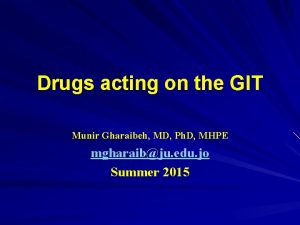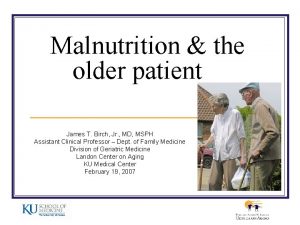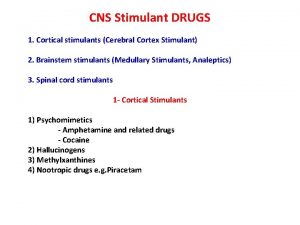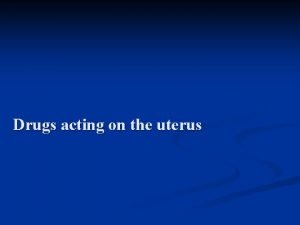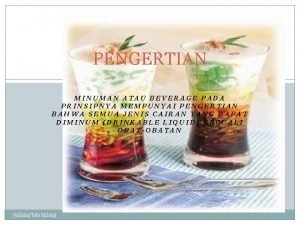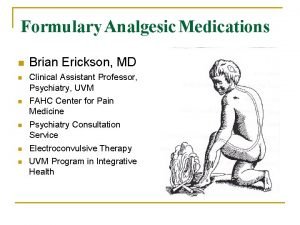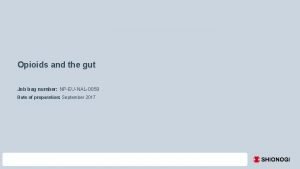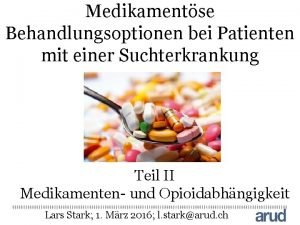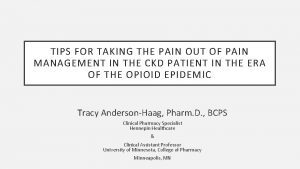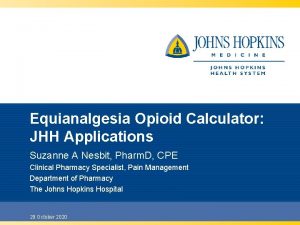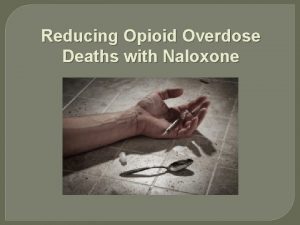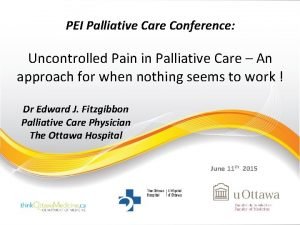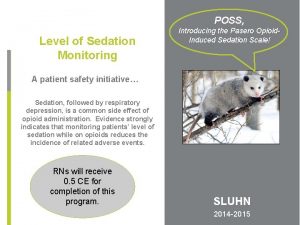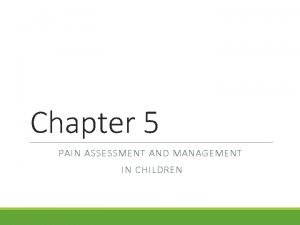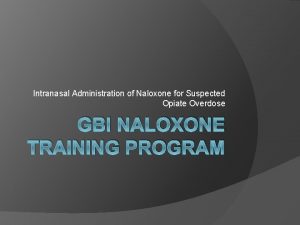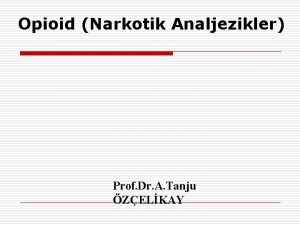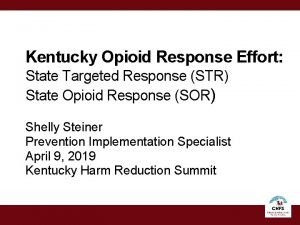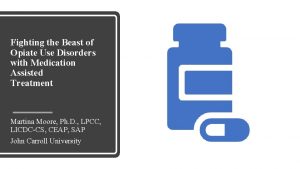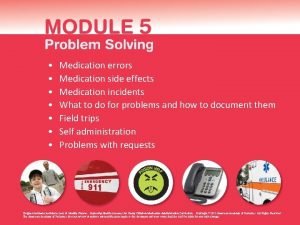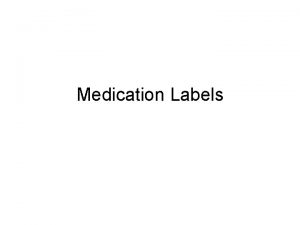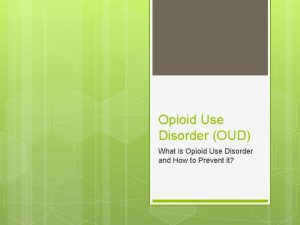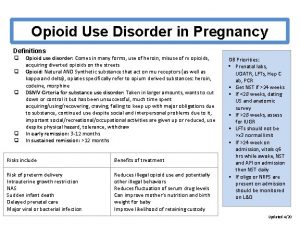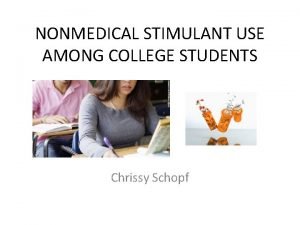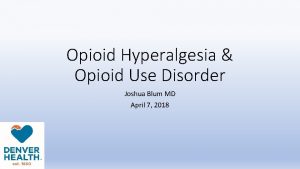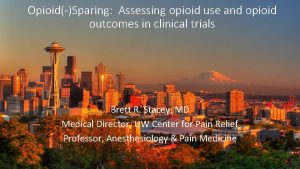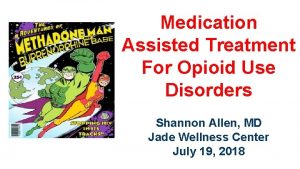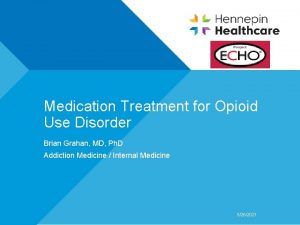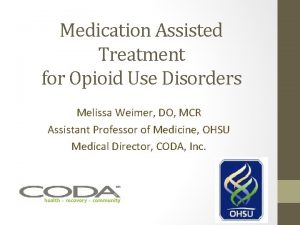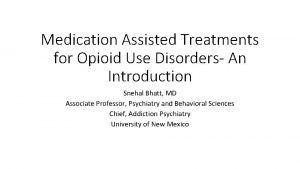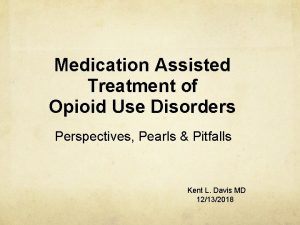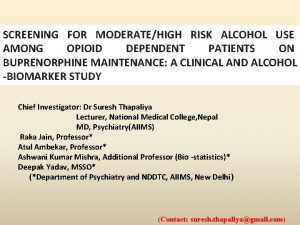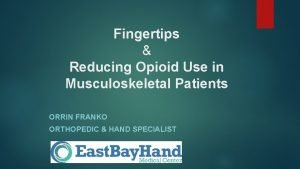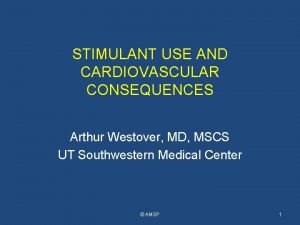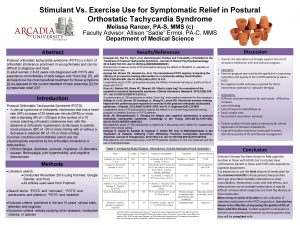Stimulant Use Among Patients on Medication for Opioid



































































- Slides: 67

Stimulant Use Among Patients on Medication for Opioid Use Disorder (MOUD): Do We Have Any Answers? Richard Rawson, Ph. D. Professor Emeritus, UCLA Integrated Substance Abuse Programs Research Professor, University of Vermont December 6, 2018

Disclosures I have no conflicts of interest to disclose.

Agenda Stimulant Use Among Patients on Medication for Opioid Use Disorder (MOUD) – Richard Rawson, Ph. D. Addressing Stimulant Use in Clinical Practice – Joe Sepulveda, M. D. Questions/Discussion

Cocaine use by patients on methadone: We’ve been here before In the late 1980 s and 1990 s, the cocaine epidemic seriously damaged the treatment progress of many patients on methadone. In many OTPs, 70% + of UAs were positive of cocaine. The treatment progress for many patients on methadone and who had not used illicit drugs for years was seriously degraded by high levels of cocaine use. This was particularly true once crack became available. Dramatic increases in injection drug use, HIV, Hep C and drugrelated crime were associated with the elevated cocaine use. Premature treatment termination/drop-out rates increased dramatically. Many OTPs became locations for cocaine dealing and associated behaviors

Methamphetamine use among patients with chronic opioid use is on the rise Ellis, MS, Kasper, ZA, Cicero, TJ (2018). Twin epidemics: The surging rise of methamphetamine use in chronic opioid users. Drug and Alcohol Dependence, v 193, 1 Dec 2018, 14 -20.


What do patients on MOUD say about stimulant use? VERY modest exploratory interview project in Vermont with 12 patients on MOUD who were current, or recent users of stimulants. 6 men; 6 women 8 use or used cocaine; 4 meth 6 injected; 6 smoked 8 were current users; 4 had stopped for at least 3 months. 8 on methadone; 4 on buprenorphine

What did the patients say? Reported availability of cocaine (and more recently meth) has greatly increased in past year. Is available from people who previously only sold opioids Drug history: 11 of 12 had used cocaine before using opioids. 3 of those individuals said they started opioids (pills) to “mellow out” from cocaine effects. 8 reported that they felt the effects of stimulants were more “addicting” than opioids. (They were referring to the fact that their opioid use was driven to avoid withdrawal. Their stimulant use was driven by a response to craving and desire for drug effect. )

What did the patients say (continued) ? What are/were the challenges of stopping stimulant use? Love the drug effect and in a perfect world would use all the time Craving/desire Drug is very powerful and ambivalent about stopping is widely available in inexpensive dosage forms Craving is triggered by many things Coming to the clinic Standing in long dosing lines with drug conversations Parts of town Drug using friends Dealers phone calls Boredom

Continued: What did the patients say? Was any form of treatment useful? 2 people reported that drug court was the key to their stopping 2 people had previously been in a study of contingency management and found it very useful With both of these “interventions” patients said the immediate certain consequences resulting from the results of a UA gave them something to “hold on to”. Although in drug court the main focus is on the negative contingency, the 2 patients talked about how rewarding it was to get the praise from the drug court folks and the judge for giving stimulant free samples.

Methadone vs Buprenorphine: Is there a different response to stimulant use? Don’t know. We do not have good data on rates of stimulant use comparing patients on methadone with those on buprenorphine. Preclinical research in the 80 s and 90 s suggested that buprenorphine may be useful in reducing stimulant use. Several studies compared methadone and buprenorphine for the treatment of individuals who used opioids and cocaine. Both studies showed that both medications reduced opioid use but did not affect cocaine use. Ling et al 2016 reported mixed results when buprenorphine was used to treat cocaine dependent individuals. Some measures indicated a reduction of cocaine use, other measures concluded no effect.

Important Clinical Issues When Treating Stimulant Users

Clinical Challenges with Stimulant Dependent Individuals Limited Understanding of Stimulant Addiction Ambivalence about need to stop use** Cognitive Impairment and poor memory Short attention span Anhedonia Powerful Pavlovian trigger-craving response Sleep Disorders Poor Retention in Outpatient Treatment Elevated Rates of Psychiatric Co-morbidity ***Especially true for individuals on MOUD

Special treatment consideration should be made for the following groups of individuals: Female stimulant users (higher rates of depression; very high rates of previous and present sexual and physical abuse; responsibilities for children). Injection users (very high rates of psychiatric symptoms; severe withdrawal syndromes; high rates of hepatitis). Users who take stimulants daily or in very high doses. Homeless, chronically mentally ill and/or individuals with high levels of psychiatric symptoms at admission. Individuals under the age of 21.

Craving for stimulants is a central and very powerful component of stimulant dependence Classical The brain and addiction Craving For conditioning and craving is automatic and creates a powerful push to use many the craving seems overpowering and uncontrollable. The craving is triggered by external (people, places, things, times of day) and internal (emotional states) stimuli. Managing exposure to triggers and responses to triggers is important

TRIGGERS “Triggers” are people, places, things, times of day, emotions that have been associated with cocaine/MA use. When users come in contact with these triggers they “automatically” begin to crave drugs and are at risk to use

Triggers to Use Trigger Thought Craving Use

Key Points with clinical implications Powerful reflexive, conditioned cravings. Requires Avoid behavior change drug using friends Treatment sessions can trigger cravings. Cognitive impairment. With currently active users, memory is impaired Long therapy sessions are pointless Provide simple, redundant, information Schedule. Write it down.

Insight is not enough… “And then it hit me: I’m salivating over a damn bell. ”

Research on “What Works”

First, What Doesn’t Work Intensive, process group therapy sessions discussing stimulant use or emotionally volatile content. Confrontation Medications Insight-oriented Generic Kicking psychotherapy CBT people out of treatment (Really, really bad idea).

Contingency Management = Motivational Incentives


Why talk about contingency management? It has been “endorsed” by NIDA (1999) It appears on most every list of evidence-based practices for treating substance use disorders (e. g. , ADAI, 2005) It has been singled out, along with CBT and MI as being an effective psychotherapy for treating substance use disorders (Carroll & Onken, 2005)

A meta-analysis reports that Contingency Management results in a successful treatment episode 61% of the time while other treatments with which it has been compared result in a successful treatment episode 39% of the time (Prendergast, Podus, Finney, Greenwell & Roll, 2005)

Behavior can be modified by: Rewards Punishments



How Incentives Could Work For You Give Incentive Patient attends treatment, gives negative samples More patients • attend treatment • give negative samples

Basic Behavioral Principles 1. Frequently monitor target behavior 2. Provide incentive when target behavior occurs 3. Remove incentive when target behavior does not occur

Research on Contingency Management/Motivational Incentives

Research studies on CM: Higgins, et al; Petry et al; Roll et al; Rawson et al. All studies compare a treatment group vs a treatment group with CM added. In all studies, treatment plus CM produced very large positive effects over the treatment alone. CM reduced stimulant use, improved attendance, produced long periods of sustained abstinence.

Contingency Management: Higgins et al. , 1993 100% 90% 80% 68% 70% 58% 60% Standard Treatment 50% 42% 40% 30% 20% 11% 10% 5% 0% Completed Treatment 8 weeks continuous abstinence 16 weeks continuous abstinence CRA & CM

CM with Methamphetamine Users Roll et al, 2006 NIDA Clinical Trials Network 113 methamphetamine users TAU, or TAU plus CM 12 week; 2 urine samples per week Fishbowl drawings (50% “good job”; 42% worth $1$5; 8% worth $20; 1 worth $80 -$100) Max possible about $400

CM with Methamphetamine Users (Cont. ) Roll et al, 2006 Samples Negative for Stimulants and Alcohol 16 14 12 10 8 6 4 2 0 Mean Weeks Continuous Abstinence 13, 9 6 4, 6 5 9, 9 4 2, 8 3 2 1 0 TAU t=2. 55 p=. 01 TAU CM t=2. 38 p=. 02 CM

Motivational Incentives for Enhanced Drug Abuse Recovery Percentage of drug-free urine samples Incentives Improve Outcomes in Methamphetamine Users Week Roll, et al. 2006

Percent of Patients Retained Retention Treatment as Usual Incentive Weeks Petry et al. , 2000

Percent Positive for Any Illicit Drug Treatment as Usual Incentive Petry et al. , 2000

Research with cocaine using patients on methadone. Rawson, et al 2002 160 patients on methadone who were cocaine dependent randomly assigned to one of 4 conditions, each 16 weeks long: 1. 2. Methadone maintenance treatment as usual (MMTP-only) MM with 3 X weekly CBT groups (CBT) 3. MM with 3 X weekly UAs and contingency management (CM) 4. All MM with 3 x weekly CBT and CM (CBT+CM) patients completed batteries of assessments at 17 weeks (end of study, 26 weeks and 52 weeks).

Days of cocaine-free Uas out of 48 (Rawson et al 2002)

Percent of participants who achieve 3 consecutive weeks of cocaine abstinence

Application of Contingency Management



Other examples of reinforcers Donuts, cookies, pizza for attendance or urine results Grocery-gasoline, etc vouchers/credit cards Preferred parking or dosing hours Certificates or plaques for accomplishments Local businesses may donate





Implementation Tips Give reinforcement frequently Easy to earn initially (set the bar low) Reinforcers should be items of use and value to patients Reinforcement should be connected to specific, observable behavior Minimize delay in reinforcement delivery; greater delay, weaker effect Focus on small steps; any improvement Simple is better

The Matrix Model is a collection of treatment materials that are organized to provide an outpatient treatment program for individuals addicted to drugs and alcohol. The Matrix manual has been developed and tested with individuals dependent upon cocaine and MA, but is commonly used with other alcohol and drug users. Evidence of efficacy with patients with MA dependence. Rawson, et al, 2004). However, not practical, nor are there data to support use with patients on MOUD. Specific CBT exercises and tools from the Matrix materials may be useful with patients on MOUD.

Elements of CBT

Cognitive Behavioral Therapy & Relapse Prevention Cognitive Behavioral Therapy (CBT) (also referred to in the addiction field as “Relapse Prevention Therapy”) is a form of talk therapy that emphasizes modification of cognitions and behaviors as a strategy to reduce drug use. CBT involves coaching and teaching patients about the cognitions and behaviors critical to reducing drug and alcohol use. CBT can be delivered in individual and group sessions.

The 5 Ws The time periods when the client uses drugs The places where the client uses and buys drugs The external cues and internal emotional states that can trigger drug craving (why) The people with whom the client uses drugs or the people from whom she or he buys drugs The effects the client receives from the drugs ─ the psychological and physical benefits (what happened)

Behavioral CBT Concepts In the early stages of CBT treatment, strategies emphasize behavior change, and include: Setting a schedule to promote engagement in behaviors that are inconsistent with substance use Recognizing Avoiding Engaging and avoiding “high risk” situations drug-using friends in new positive activities promoting abstinence (eg. Exercise and AA/NA groups)

Cognitive CBT Concepts As CBT treatment continues into later phases of recovery, more emphasis is given to the “cognitive” part of CBT. This includes: Keep track of days of use and reward reduction Psychoeducation Teaching regarding addiction clients about triggers and cravings Teaching clients cognitive skills (e. g. , “thought stopping” and “urge surfing”) When relapse occurs, examine factors that led to use.

Summary Behavioral strategies in CBT include scheduling and avoiding high risk situations. Cognitive strategies include recognizing triggers and cravings, thought stopping, recognizing “red flag thoughts, ”and analysis of the chain of events that result in a “slip” or “lapse. ” Optimally, CBT strategies can be used while practicing a style of interaction that is consistent with M. I. CBT effects are robust across substances of abuse.

Exercise

Rationale to Study Exercise for Substance Use Disorders Exercise increases dopamine levels in the brain (Hattori et al. , 1994) Negative affect states (depression, anxiety) may predispose individuals to relapse. Cognitive deficits evident after prolonged substance use. Emerging evidence from animal and human studies that exercise may be useful in treatment and prevention of SUDs (Thanos et al. , 2010; Brown et al. , 2010; Buchowski et al. , 2011) Positive effects on tobacco cravings, withdrawal symptoms, and smoking-related behaviors (Taylor et al. , 2007; Bock et al. , 1999)

Aerobic Exercise for Methamphetamine (MA) Dependence: Study Design A study (Rawson et al. , 2012) compared effects of an aerobic and resistance exercise intervention (“Exercise”) compared to health education (“Education”) among MA users during and after residential drug treatment. An 8 week, three times per week, one hour session of aerobic and strength training, monitored by a professional trainer was compared to the same schedule of health education sessions with a health educator.

Exercise Results Lower severity methamphetamine users had significantly fewer positive urine results at the 3 follow-up points Exercise group participants had significantly lower scores on a measure of depression compared to the ED group over the 8 -week treatment period. Exercise group participants had significantly lower scores on a measure of anxiety compared to the ED group over the 8 -week treatment period.

Aerobic Exercise for Methamphetamine Dependence: Results Exercise significantly reduced anxiety and depression symptoms in the first 8 weeks of MA withdrawal. Exercise reduced weight gain and increased strength and heart rate variability. Exercise produced more rapid regrowth of D 2 receptors and transporters Exercise reduced post-discharge MA relapse for all except the most severe patients.

Exercise Summary MA users can engage in exercise Resistance and aerobic exercise delivered 3 Xs/week over just 8 weeks confers benefits to physical health, mood, and dopamine receptor availability in MA users Optimal Further type and duration of exercise unknown exploration of exercise in conjunction with other forms of therapy as well as effects on drug use is warranted

The Use of Technology in Addiction Treatment

Thank you Richard Rawson, Ph. D. rrawson@mednet. ucla. edu RRAWSON@UVM. EDU

Addressing Stimulant Use in Clinical Practice Joe Sepulveda, M. D. Assistant Medical Director, Family Health Centers of San Diego (FHCSD)

Questions/Discussion
 Esmoprazole
Esmoprazole Definition malnutrition
Definition malnutrition Cortical stimulants
Cortical stimulants Uterine stimulants examples
Uterine stimulants examples Squashes adalah minuman yang mengandung
Squashes adalah minuman yang mengandung Brian erickson md
Brian erickson md Opioid receptors location
Opioid receptors location Ecotussin
Ecotussin Non-opioid
Non-opioid Suzanne nesbit
Suzanne nesbit Opioid overdose
Opioid overdose Mechanism of action of opioid analgesics
Mechanism of action of opioid analgesics Poss sedation scale
Poss sedation scale Non-opioid
Non-opioid Opioid overdose
Opioid overdose Nips pain scale
Nips pain scale Karma etkili opioidler
Karma etkili opioidler Kentucky opioid response effort
Kentucky opioid response effort Opioid overdose
Opioid overdose Sims positon
Sims positon Why do individual languages vary among places?
Why do individual languages vary among places? Tack för att ni har lyssnat
Tack för att ni har lyssnat Centrum för kunskap och säkerhet
Centrum för kunskap och säkerhet Läkarutlåtande för livränta
Läkarutlåtande för livränta Treserva lathund
Treserva lathund Inköpsprocessen steg för steg
Inköpsprocessen steg för steg Påbyggnader för flakfordon
Påbyggnader för flakfordon Tack för att ni lyssnade
Tack för att ni lyssnade Egg för emanuel
Egg för emanuel En lathund för arbete med kontinuitetshantering
En lathund för arbete med kontinuitetshantering Formel gruplar
Formel gruplar Atmosfr
Atmosfr Rutin för avvikelsehantering
Rutin för avvikelsehantering Vanlig celldelning
Vanlig celldelning Presentera för publik crossboss
Presentera för publik crossboss Myndigheten för delaktighet
Myndigheten för delaktighet Debattartikel mall
Debattartikel mall Var 1721 för stormaktssverige
Var 1721 för stormaktssverige Tobinskatten för och nackdelar
Tobinskatten för och nackdelar Tack för att ni lyssnade bild
Tack för att ni lyssnade bild Mall för referat
Mall för referat Verifikationsplan
Verifikationsplan Karttecken brant
Karttecken brant Luftstrupen för medicinare
Luftstrupen för medicinare Rbk-mätning
Rbk-mätning Kraft per area
Kraft per area Elektronik för barn
Elektronik för barn Underlag för särskild löneskatt på pensionskostnader
Underlag för särskild löneskatt på pensionskostnader Förklara densitet för barn
Förklara densitet för barn Tack för att ni har lyssnat
Tack för att ni har lyssnat Borra hål för knoppar
Borra hål för knoppar Bris för vuxna
Bris för vuxna Smärtskolan kunskap för livet
Smärtskolan kunskap för livet Frgar
Frgar Argument för teckenspråk som minoritetsspråk
Argument för teckenspråk som minoritetsspråk Tallinjen
Tallinjen Delegerande ledarskap
Delegerande ledarskap Humanitr
Humanitr Vad står k.r.å.k.a.n för
Vad står k.r.å.k.a.n för Toppslätskivling dos
Toppslätskivling dos Redogör för vad psykologi är
Redogör för vad psykologi är Bra mat för unga idrottare
Bra mat för unga idrottare Lek med geometriska former
Lek med geometriska former Etik och ledarskap etisk kod för chefer
Etik och ledarskap etisk kod för chefer Publik sektor
Publik sektor Datorkunskap för nybörjare
Datorkunskap för nybörjare Kvinnlig mantel i antikens rom
Kvinnlig mantel i antikens rom Tidböcker
Tidböcker
